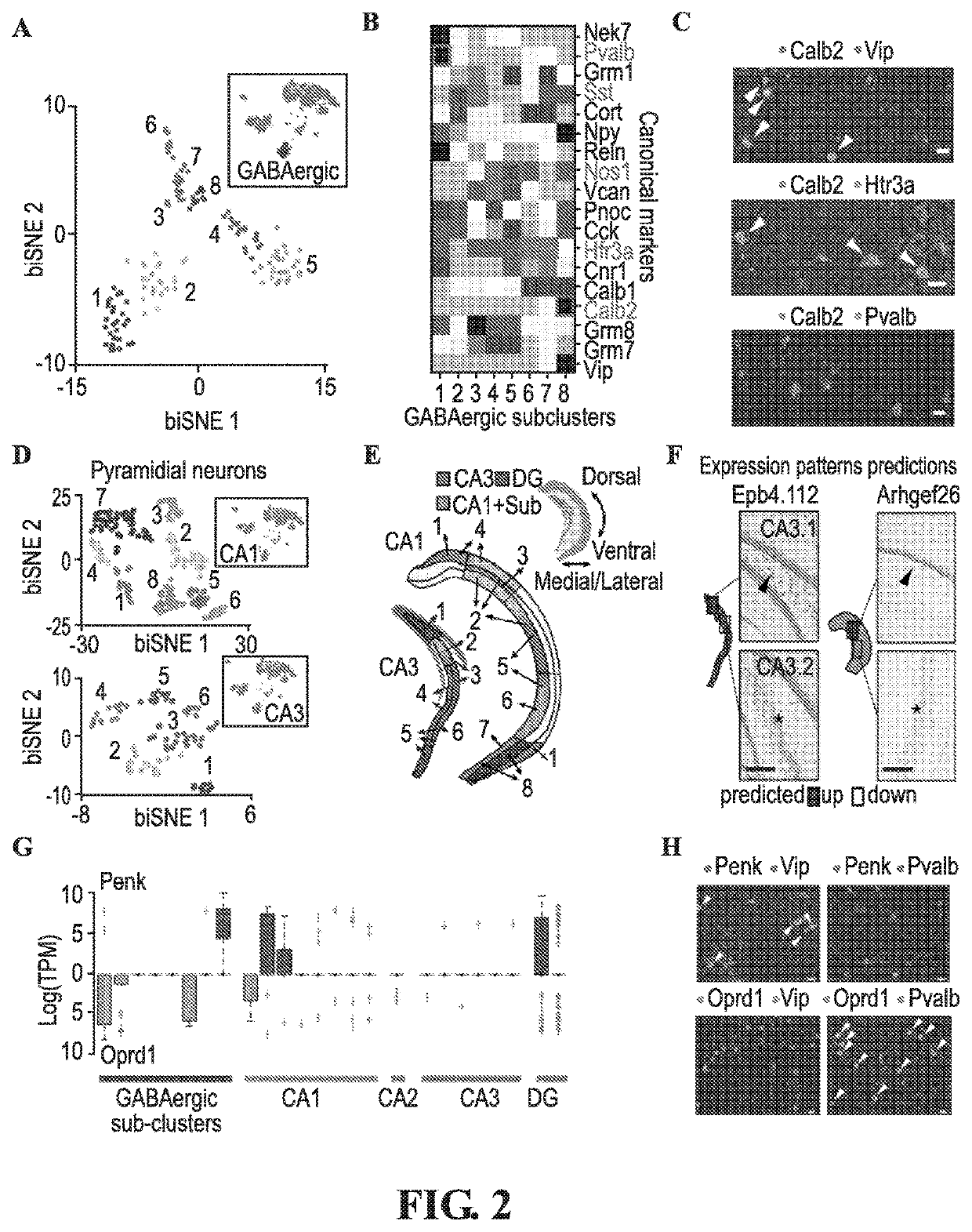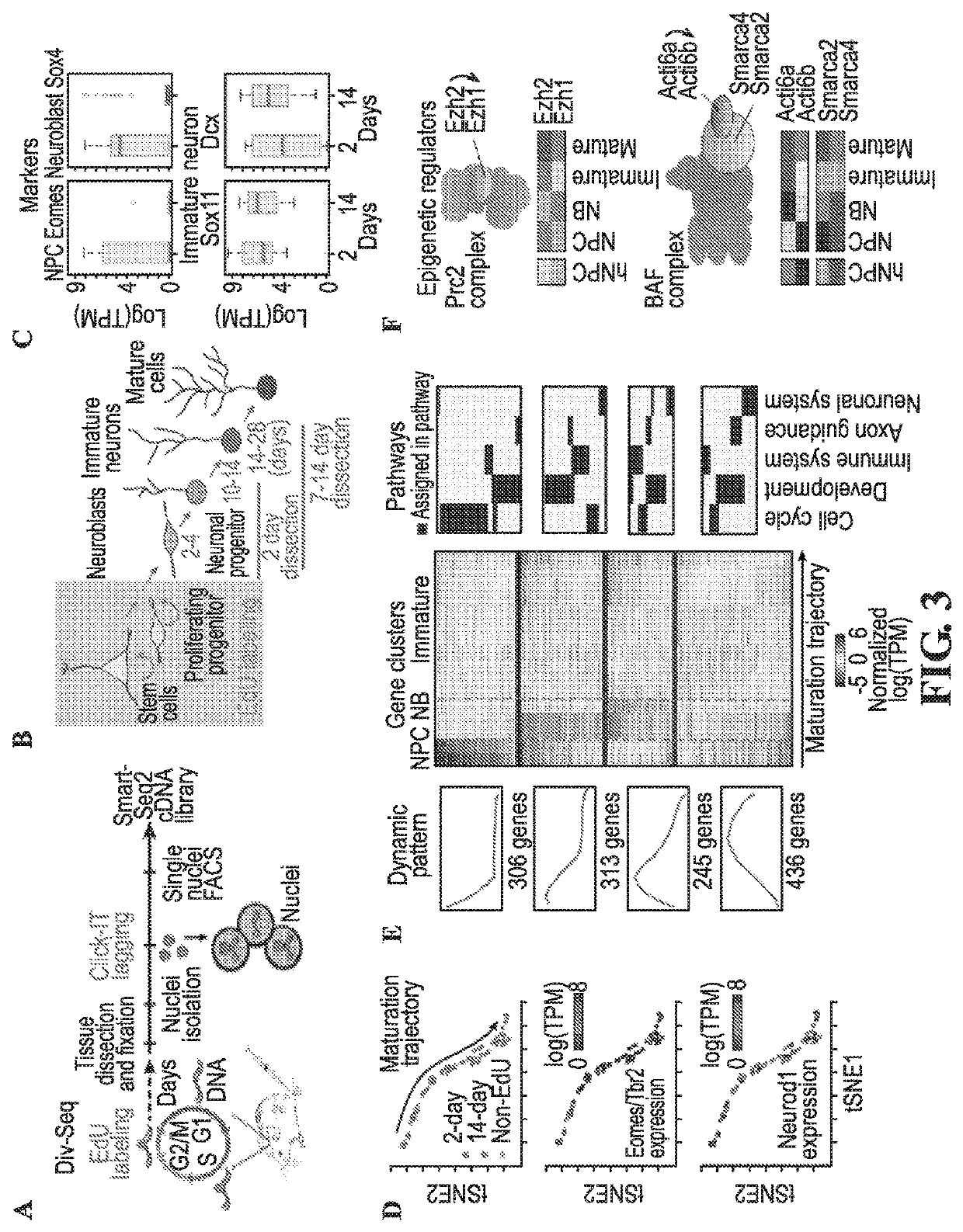Methods for determining spatial and temporal gene expression dynamics during adult neurogenesis in single cells
a gene expression and single cell technology, applied in the field of single cell gene expression dynamics for adult neurogenesis, can solve the problems of difficult capture of rare dynamic processes, difficult isolation from dense adult tissue, and difficult study of key dynamic processes that occur in dense nervous tissues, such as adult neurogenesis
- Summary
- Abstract
- Description
- Claims
- Application Information
AI Technical Summary
Benefits of technology
Problems solved by technology
Method used
Image
Examples
example 1
[0861]Applicants have developed methods of performing a high-throughput single-nucleus isolation and RNA-Seq method compatible with fresh, frozen, or fixed tissue (Nuc-seq). The uniform shape and fixation of the isolated nuclei (FIG. 1A) combined with nuclei labeling (FIG. 5) enables enrichment of rare cell populations by fluorescent-activated cell sorting (FACS). The method was further developed for temporal analysis of dividing cells by addition of unbiased labeling with 5-ethynyl-2′-deoxyuridine (EdU), which is incorporated into the DNA of dividing cells (8), and using Click-IT to fluorescently tag the isolated EdU labeled nuclei, which can be readily captured by FACS (FIG. 5) (Div-seq).
[0862]Earlier studies have shown the feasibility of single neuronal nuclei RNA-seq (9-11), however, it was previously unclear whether the type and complexity of nuclear mRNA could be effectively used for sensitive classification of cell types and states in the CNS on a large scale. Furthermore, gi...
example 2
[0864]The present invention also provides for novel methods to analyze the Nuc-Seq data and generate high resolution maps (see materials and methods). Nuc-Seq analysis sensitively identified both major cell types and refined sub-types. Cluster analysis of Nuc-Seq data revealed seven major clusters of cells with distinct gene expression patterns (FIG. 1E-G, FIG. 8 and FIG. 9) that clearly correspond to known cell types and major anatomical distinctions in the hippocampus. Cluster identities were consistent with Applicants' microdissection scheme, and their gene expression patterns globally agreed with Allen Brain Atlas ISH data (Allen ISH(13), FIG. 9). Iterative re-clustering of the glia nuclei (cluster 7 in FIG. 1E. FIG. 10) recovered five known glial cell sub-types (14), and averaged expressions across each sub-cluster well-correlated with published population RNA-Seq data (14) (FIG. 10).
[0865]Applicants captured finer distinctions between closely related cell types using a new clu...
example 3
[0868]Applicants next combined Nuc-Seq with EdU labeling of dividing cells, in a method Applicants call Div-Seq (FIG. 3A). In contrast to commonly used genetic labeling techniques (3, 19, 20), which might be limited to specific cell types and requires cell types or developmental stage marker genes (3, 19, 20), EdU tags newly synthesized DNA in dividing cells at a given time window, allowing for unbiased isolation of nuclei of neural stem cells and their progeny with high temporal resolution. To study transcriptional dynamics during adult neurogenesis in the DG, one of the canonical neurogenic sites in the mammalian CNS (7), Applicants used Div-Seq to isolate nuclei at 2 and 14 days after cell division, representing neural precursor cells (NPC), neuroblasts, and immature neuronal stages of adult neurogenesis, respectively (7) (FIG. 3B, FIG. 22). Div-Seq enriched for a broad range of newborn cells (FIG. 20). Expression of stage-specific marker genes confirmed that Div-Seq captured cel...
PUM
| Property | Measurement | Unit |
|---|---|---|
| Temperature | aaaaa | aaaaa |
| Fraction | aaaaa | aaaaa |
| Fraction | aaaaa | aaaaa |
Abstract
Description
Claims
Application Information
 Login to View More
Login to View More - R&D
- Intellectual Property
- Life Sciences
- Materials
- Tech Scout
- Unparalleled Data Quality
- Higher Quality Content
- 60% Fewer Hallucinations
Browse by: Latest US Patents, China's latest patents, Technical Efficacy Thesaurus, Application Domain, Technology Topic, Popular Technical Reports.
© 2025 PatSnap. All rights reserved.Legal|Privacy policy|Modern Slavery Act Transparency Statement|Sitemap|About US| Contact US: help@patsnap.com



